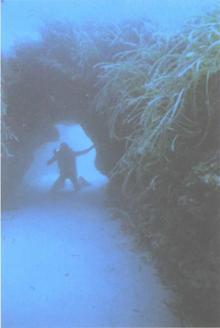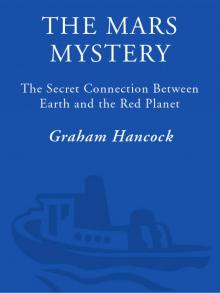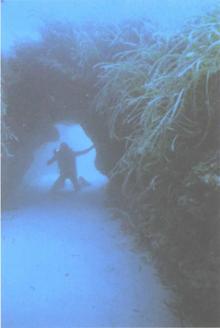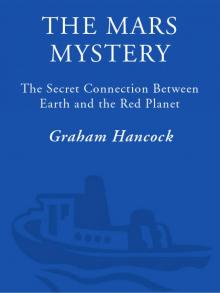- Home
- Graham Hancock
The Mars Mystery: The Secret Connection Between Earth and the Red Planet Page 3
The Mars Mystery: The Secret Connection Between Earth and the Red Planet Read online
Page 3
We can easily understand why populist politicians might wish to identify themselves with the quest for life on Mars. As Colin Pillinger sums up: “This is what people care about. When I talk to them they only ever want to know if there was life on Mars.”35
HIDDEN AGENDA?
“NASA has made a startling discovery that points to the possibility that a primitive form of microscopic life may have existed on Mars more than three billion years ago.”36
With these carefully chosen words, amid much fanfare, news of what had been found in meteorite ALH84001 was first released to the public at a press conference held on 7 August 1996 at the Johnson Space Center in Houston. The speaker was Daniel Goldin, the powerful boss of NASA, who came to the job after spending twenty-five years at TRW, a top-secret defense contractor.37
Lobbyists campaigning for more open and accountable government in the United States regard Goldin’s presence at NASA as ominous. The appointment was originally made by President George Bush, himself a former director of the Central Intelligence Agency. According to lobbyist and researcher Dan Ecker: “Ever since Goldin has been in charge many of the civilians in NASA have been replaced by former DOD [Department of Defense] people and NASA has steadily been going covert…. They have been doing many more Department of Defense missions … and remember, Dan Goldin … is the only person in charge of a federal agency that I’m aware of that was not replaced under the Clinton administration. That should speak volumes.”38
Like Ecker, many Americans are convinced that NASA has a hidden agenda and that its policies, and the information it chooses to release to the public, are influenced by factors other than the furtherance of pure science. As we shall see in later chapters, this suspicion has been particularly intense over the issue of the so-called monuments of Mars—notably the pyramids and Face of the Cydonia region. There is a public perception that NASA is involved in a sinister conspiracy to cover up significant evidence about the true nature of these anomalous structures. It has even been suggested that the whole “Mars microbe” extravaganza could have been designed to distract attention from another, more covert Mars story—perhaps to do with Cydonia.39
Such speculation sounds like paranoid fantasy. And yet other conspiracies have also been alleged, this time involving the microbes themselves. These allegations stem from reputable scientists working within NASA and cannot easily be dismissed.
MOTIVES
Meteorite ALH84001 is made of rock that has been reliably dated at more than 4.5 billion years old.40 The life traces identified within it are thought to be 3.6 billion years old. There is good evidence to suggest that the rock was splashed off the surface of Mars 15 million years ago as a result of a collision with a comet or asteroid.41 It then traveled through space as a piece of cosmic jetsam for millions of years before finally crossing Earths path just 13,000 years ago and landing amid the ice sheets of Antarctica.42
The meteorite’s modern history began on 27 December 1984 when it was found in the Allen Hills region of Antarctica. Dark green in color, with tiny rust-red patches in its crevices, it was collected by Roberta Score of the National Science Foundation who recognized it as a meteorite and shipped it to the Johnson Space Center. There, so the official story goes, it was ignored for more than eight years until researchers discovered that it had the classic chemical signature of the SNC class of meteorites and therefore must have originated on Mars.43
From 1993 until 1996, sharing almost no information at all with their peers,44 a group of NASA scientists undertook an intensive investigation of the meteorite. The team was led by David McKay and Everett Gibson of the Johnson Space Center, who later recruited two specialists, Kathie L. Thomas-Keperta of the defense contractor Lockheed Martin and Professor Richard N. Zare of Stanford University, to analyze the meteorite’s organic components with a laser mass spectrometer.45
According to Dwayne Day of the Space Policy Institute at George Washington University: “As the team became aware of the implications of their research they stopped talking to outside colleagues about it. They were wary of making any comments before they were completely sure of their evidence.”46
Rather less commendable motives have been suggested by David Des Marais, a scientist at NASA’s Ames Research Center. He thinks that the secrecy and exclusive behavior of his colleagues at the JSC probably had more to do with interdepartmental rivalry for funds than with any sense of responsibility or prudence: “There’s certainly a lot of competitiveness between NASA centers at the moment with government cutbacks, and so I can imagine why they would want to keep the discovery and announcement all to themselves and have their research and their center making the headlines.”47
NASA distributes its tasks among many centers. The speciality of Ames, where Marais works, is biological research—notably the chemical and biological experiments carried on the space shuttle. By March 1997, more than seven months after the initial sensational announcements about the Martian microbes, Ames scientists had still not succeeded in persuading the JSC to release a sample from the meteorite for them to study. “We really want to do a chemical analysis on a sample to check for signs of life,” Marais commented, “because just about everybody who has looked at the rock up until now has concentrated on its geology. Nobody has investigated its organic chemistry in depth, and we are the best resource to do that.”48
CREDIT WHERE CREDIT IS DUE
Marais is not the only NASA scientist to have been bypassed by the JSC. Others include Dr. Vincent DiPietro of the Goddard Space Flight Center in Maryland, and Dr. John Brandenburg, who works for the NASA contractor Physical Sciences, Inc.
As we saw in chapter 1, DiPietro is the co-discoverer (with Gregory Molenaar) of the D&M Pyramid in the Cydonia region of Mars. DiPietro’s support for the notion that the monuments of Cydonia could be artificial structures—rather than tricks of light and shadow—has for a long while marked him as a rebel within NASA. The same is true of Dr.John Brandenburg, with whom DiPietro has authored a number of controversial papers about Cydonia.
DiPietro points out that the story of the hunt for life in meteorites from Mars did not begin with the relatively recent efforts of the Johnson Space Center team—who have indeed grabbed all the credit—but with work started as far back as 1966 by the Dutch scientist Bartholemew Nagy. In 1975 Dr. Nagy published a paper on the presence of curious organic compounds in “carbonaceous meteorites”—subsequently confirmed to be meteorites from Mars.49 Fourteen years later, Nagy’s findings were corroborated by Colin Pillinger and his team in England in their paper “Organic Materials in a Martian Meteorite,” published in Nature in July 1989.50
Organic materials can be generated by purely chemical as well as by biological processes. In an attempt to establish which process had been involved on Mars, John Brandenburg and Vincent DiPietro undertook a detailed review of the findings of Nagy and Pillinger. By 1994 they had begun to suspect that they had found signs of life. In their paper on the subject, published in May 1996, three months before the Johnson Space Center team went public with their “discovery,” they noted that meteorites from Mars are remarkable in that they contain organic material in greater abundance than any other meteoric type. This, they concluded, “could mean evidence for primordial organo-synthesis on Mars and perhaps even primitive biology.”51
It is odd, and more than just bad manners, that NASA neglected to mention the work of Brandenburg and DiPietro, or the earlier work of Nagy, Pillinger, and Wright, when it made its sensational August 1996 announcement about the discovery of microfossils in meteorite ALH84001. Furthermore, Brandenburg and DiPietro claim that more than a year before the announcement they had personally informed NASA boss Dan Goldin of their own discovery of microfossils in meteorites from Mars. According to DiPietro, they got Goldin’s attention for “a couple of minutes” during a conference at the National Academy of Sciences in Washington and put into his hands a dossier of
writings about the meteorites from Mars which contained org
anic carbon and fossils…. On the very front cover … were the pictures of the fossils that were found. He looked at it with some kind of skepticism but also with curiosity. Prior to my putting this into his hands, I had addressed this to him in a question so it’s in the physical, audiotaped version of that meeting. I had asked him the question about the meteorites, and the fossils that were found within them, and what were NASA’s plans for them.52
Why therefore did Goldin not acknowledge Brandenburg and DiPietro’s findings when he so publicly acclaimed the parallel work of the JSC team?
Brandenburg admits, “Everyone knows we push Cydonia” as evidence of a former civilization on Mars.53 Since this view has for a long while been unpopular within NASA it has been suggested that Goldin would have been unlikely to have welcomed the prospect of Brandenburg and DiPietro being first past the post with the headline-grabbing proof that life—albeit primitive life—did indeed once exist on the Red Planet.54
We are not surprised that Goldin, and perhaps other senior officials at NASA, were well informed about the fossil evidence in Martian meteorites long before that evidence was officially made public. Many large organizations behave secretively as a matter of habit. At the end of August 1996, however, a curious and perhaps significant sidelight was cast on the story by Sherry Rowlands, a thirty-seven-year-old prostitute who claimed to have had an affair with President Clintons adviser Dick Morris. In press interviews she kept on insisting that Morris had told her about “the discovery of the evidence of a life-form on Mars when it was still a military secret.”55
LITTLE GREEN MEN
However faint the traces, the smell of intrigue and power politics does hang over the mystery of life on Mars. And yet, what could anybody possibly have to hide?
At the August 1997 press conference Daniel Goldin praised the JSC team for “their dedication, knowledge, and painstaking research,” and for making discoveries “that may well go down in history for American science, for the American people and indeed for humanity.”56 At the end of this eulogy he was at pains to emphasize that “we are not talking about little green men.’ The [fossils] are extremely small, single-cell structures that somewhat resemble bacteria on Earth. There is no evidence or suggestion that any higher life-form ever existed on Mars.”57
The best that can be said about Goldin is that he seems to have been “economical with the truth” when he gave all the credit for the meteorite discoveries to the JSC team. Could he also have been holding something important back in the second part of his statement when he dismissed the possibility of higher life-forms on Mars? Soon after the press conference, Professor Stanley McDaniel of Sonoma State University made a telling observation about Goldin’s presentation: “Its very interesting that as long as it’s microbial life, little microbes that are certainly inferior to humans, there’s no problem in acknowledging that they may exist, but if it were big or little green men then there’s a problem.”58
There must be a reason for this problem.
3
The Mother of Life
SCIENCE has yet to explain how, why, when, and where life first emerged. Did it begin on Earth? That is just an opinion. Did it come about as a result of chance combinations of molecules in the “primeval soup”? That is also just an opinion—and so is the opposite opinion that it was the work of a creator. The unvarnished truth, as the biologists Stanley Miller and Leslie Orgel have admitted, is that “we do not know how life began.”1
Even so, there is agreement on a number of fundamental points. The most important is that “the detection of water in liquid form is the essential indicator for life.”2 According to the biologist Anders Hansson, water, as an inert solvent, “is ideal for biochemical cycling. Szent-Gyorgyi [the Nobel Prize-winning biochemist and discoverer of vitamin C] has called it ‘the matrix of life.’ Without it life cannot take hold nor the Darwinian evolution begin.”3
In a realm of science where there are few hard facts this, too, is just another opinion. Nevertheless it is a well-informed opinion and we have no reason to suppose it to be wrong.4 Until new evidence emerges to the contrary—and because we know that it was so on our own planet Earth—it therefore seems sensible to accept that water is probably a necessary precondition for the emergence of life anywhere in the universe.
Mars today is dead and dry, and cold as hell. With an average overall temperature of minus 23 C, it has no liquid water but only frozen water in the form of ice. Indeed, water in liquid form cannot survive on the surface for more than a few seconds in such a climate. It has therefore been baffling to discover, since the era of spacecraft exploration and close-up photography began, that much of the planet shows unmistakable evidence of former oceans, lakes, and rivers, of plentiful rainfall, and of catastrophic floods on a gigantic scale that once scoured its surface.
ICE, DUNES, AND STORMS
Even under the most favorable viewing conditions telescopic observations of Mars can produce misleading results. As we saw in chapter 1, the optical illusion of so-called irrigation canals led Percival Lowell and others in the late nineteenth century to conclude that “Mars is inhabited by beings of some sort or other.”5 The effect was to raise public expections for more than fifty years. Indeed, as late as the mid-1960s, there were many who still confidently expected that the reality of canals would be confirmed by NASA spacecraft. When it was discovered that no canals existed there was widespread disillusionment and a general loss of interest in Mars and its mysteries.
Although the canals are not real, other Martian phenomena, well documented in telescope observations and confirmed by photometric studies, are harder to dismiss as optical illusions. Among these one of the most intriguing is referred to by astronomers as “the wave of darkening”:6
Near the edge of either polar cap, a general darkening of the surface markings appears in early spring as the cap begins to recede. The darkening then moves away from the receding polar cap and sweeps toward and crosses the equator in a distinct band of heightened contrast, finally dissipating in the opposite hemisphere. The waves, one in each hemisphere, travel at an apparent speed of about 35 kilometers per day.7
The southern polar cap of Mars, at its maximum extent, reaches as far toward the equator as 50 degrees south. The northern cap extends to latitude 65 degrees north, much farther from the equator. By measuring the “reflection spectra” of the caps scientists have discovered what they consist of. The southern cap, by far the colder of the two, is entirely carbon dioxide ice. The northern cap contains fluctuating quantities of carbon dioxide ice but always maintains a permanent remnant, about 1,000 kilometers across, of pure water ice.8 This is thought to represent “the largest reservoir of available water on the planet.”9
Surrounding the polar ice, and disappearing beneath it, are what geologists refer to as “extensive layered deposits.”10 Believed to have been carried here by wind, these are cut through by narrow sinuous valleys and circumscribed by the largest sea of sand dunes, or “erg,” in the solar system:11 ‘This erg forms a band of windblown sand entirely around the north polar remnant cap. The dunes in this region are spectacular in their regularity over hundreds of kilometers.’12
From time to time awe-inspiring storms are whipped up on the surface of Mars. For reasons that are not yet understood such storms are usually preceded by a period of sudden local turbulence at certain preferred locations in the southern hemisphere during which tremendous quantities of surface dust get thrown as high as 10 kilometers into the atmosphere. Powerful winds then carry the dust to all parts of the planet, rapidly obscuring its entire surface. Thereafter the intensity of the storm begins to lessen and within a few weeks the atmosphere returns to normal.13
EXTRAORDINARY SURFACE FEATURES
Where Earth is mellow and adorned with gentle curves, Mars is a planet of jagged extremes. Its valleys are the lowest in the solar system, its canyons the deepest, its volcanoes the highest. In the absence of an existing sea level, scientists refer to altitudes and depths o
n Mars in terms of an arbitrary “datum” level. The summit of the giant volcano Olympus Mons, at 27 kilometers above datum, is the highest point on the planet, and the floor of the canyon system known as the Valles Marineris, at seven kilometers below datum, is the lowest point.14
Olympus Mons looks like a vision from some dark fairy tale. It is classified by geologists as a “shield volcano” and consists of a circular scab of lava, 700 kilometers in diameter, rising toward a summit caldera 80 kilometers in diameter.15 The outer edge of the lava scab, around a circumference of almost 5,000 kilometers, is defined by cliffs that drop sheer to the surrounding plains six kilometers below.16
Southwest of Olympus Mons is the Elysium Bulge, an immense area of high ground that is surmounted by three volcanoes. The highest of these, Elysium Mons, rises 9 kilometers above the surrounding plains.17 Southeast of Olympus Mons, at a distance of 1,600 kilometers, begins an even larger upswelling of land. Known as the Tharsis Bulge, it rises 10 kilometers above datum and measures more than 4,000 kilometers from north to south and 3,000 kilometers from east to west—about the size of Africa south of the Congo River.18 It is in its turn surmounted by three gigantic shield volcanoes—Arsia Mons, Pavonis Mons, and Ascraeus Mons—which are known collectively as the Tharsis Montes.19 Riding on the broad shoulders of the Tharsis Bulge their peaks rise to 20 kilometers above datum and always remain visible to spacecraft during even the greatest Martian dust storms.20
At the eastern edge of the Tharsis Bulge, Mars seems to have been split open by some catastrophic force. Amid a bizarre series of interconnecting box canyons and depressions known as the Noctis Labyrinthis, a tremendous meandering furrow opens in the surface of the planet and runs east—roughly parallel to the equator but between 5 and 20 degrees south of it—for a distance of 4,500 kilometers.21

 Underworld: The Mysterious Origins of Civilization
Underworld: The Mysterious Origins of Civilization The Master Game: Unmasking the Secret Rulers of the World
The Master Game: Unmasking the Secret Rulers of the World America Before
America Before Entangled
Entangled War God: Nights of the Witch
War God: Nights of the Witch War God: Return of the Plumed Serpent
War God: Return of the Plumed Serpent The Message of the Sphinx AKA Keeper of Genesis
The Message of the Sphinx AKA Keeper of Genesis Fingerprints of the Gods
Fingerprints of the Gods The Sign and the Seal
The Sign and the Seal The Mars Mystery: The Secret Connection Between Earth and the Red Planet
The Mars Mystery: The Secret Connection Between Earth and the Red Planet Magicians of the Gods: The Forgotten Wisdom of Earth's Lost Civilization
Magicians of the Gods: The Forgotten Wisdom of Earth's Lost Civilization War God
War God Underworld
Underworld The Mars Mystery
The Mars Mystery Magicians of the Gods
Magicians of the Gods The Master Game
The Master Game